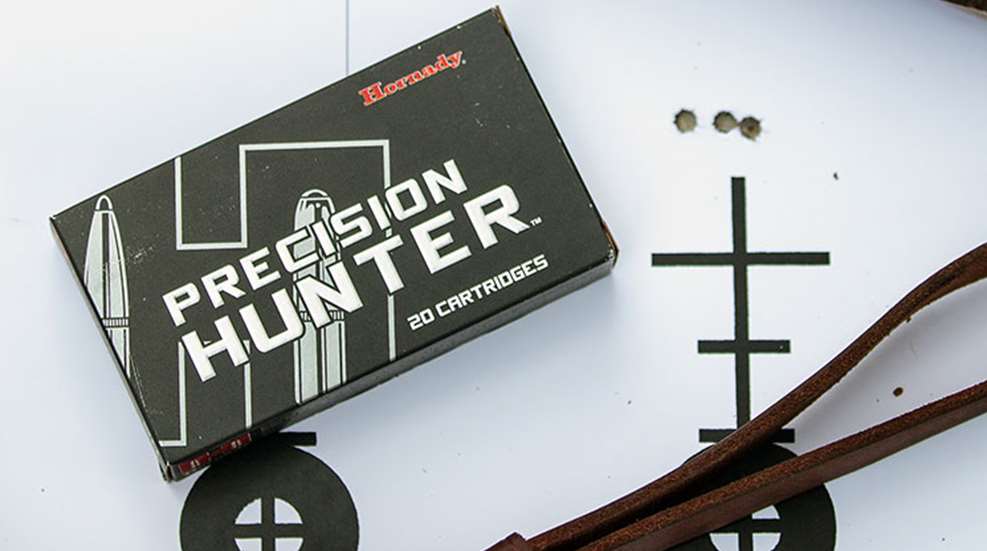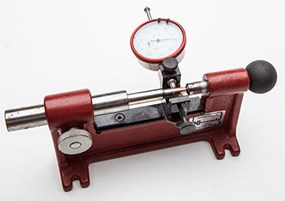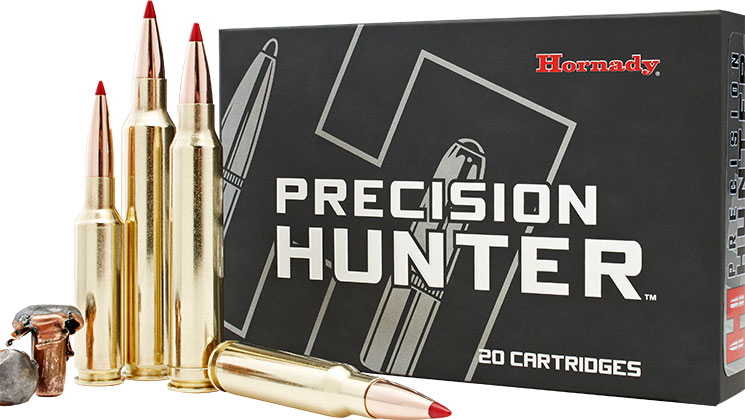
Hunters are shooting animals at pretty long distances these days. Hornady is in the business of making products that hunters and shooters want. And since hunters are looking for bullets that will work across a wide spectrum of velocities—bullets that will provide reliable performance on game from the muzzle to many hundreds of yards, you can see where I'm going with this. Hornady has created such a bullet in the ELD-X and has chambered it in its Precision Hunter line of loaded ammunition.
I learned the hard way that all bullets aren’t great at all distances when I shot an elk at just over 300 yards with a 400-grain bullet from a .404 wildcat; the bullet failed to expand and, despite a double lung hit, the cow was unimpressed. Yes, I finished the job and, no, it wasn’t pretty. Creating a bullet that will work effectively on game at, say, 600 yards isn’t brain surgery: You design a bullet that will expand reliably at 1800 fps or so and you’re in business. But, wait—what if that elk you were planning to shoot across the canyon appears in the timber at 75 yards? Your 600-yard bullet may very well come apart when it hits bone at 2900 fps. You’ve now wounded an animal that you’ll likely never recover. Using a bullet that isn’t up to the task is as irresponsible as taking a long-range shot that you are incapable of making with confidence. Hornady sought to address this dilemma and, in doing so, stumbled upon an issue that just about no one had thought of.
Hornady’s ballistic engineers had designed a bullet that would work across a wide spectrum of velocities—a bullet suited equally for the cross-canyon shots and the point blank encounters in the timber. Satisfied with the terminal performance of the bullet, they began the careful process of establishing an accurate ballistic coefficient (BC) figure for their new bullet. Instead of using traditional equipment, they used Doppler radar to track the bullet during its entire flight path. By analyzing this data, Hornady’s engineers determined that their new bullet’s BC was actually changing mid-flight which made predictable trajectory calculations impossible. They realized that the bullet’s polymer tip was deforming due to the heat generated by the friction between the bullet and the air- the tips were basically melting. Further testing exposed that every polymer-tipped bullet on the market was subject to the same deformation; this wasn’t just a Hornady issue.
The engineers went back to the drawing board and developed a polymer tip that would withstand the heat forces and maintain a consistent BC throughout its flight path. The ELD-X (Extremely Low Drage-eXpanding) hunting bullet was born. Seven ELD-X component bullets are currently offered in 6.5mm, 7mm, and .30 caliber. You don’t have to handload to use the ELD-X, though, as Hornady’s Precision Hunter line offers these cutting edge projectiles in eight different chamberings. We tested Hornady’s Precision Hunter ammunition in 6.5 Creedmoor, 308 Winchester, and 7mm Remington Magnum, three popular and serviceable cartridges that are useful for a variety of hunting scenarios.
Precision Hunter loads all use ELD-X bullets and, in each case, the bullets are heavy-for-caliber. This may seem counterintuitive to some as heavy bullets aren’t capable of the velocities of lighter examples but those long and heavy bullets maintain their velocity over distances and actually drop less at long range than light bullets. The Precision Hunter 6.5 Creedmoor load uses a 143-grain bullet at 2700 fps of advertised velocity, the 308 uses a 178-grain at 2700 fps, and the 7mm Remington Magnum load pushes a 162-grain ELD-X at 2900 fps. The actual average velocities that we recorded during our testing were lower in each case, but not by a significant margin.
Before we fired a single round of this ammo, we inspected it for evidence of precision manufacturing processes. We did so by selecting ten rounds of each load randomly, and measured the bullet run-out of each using a Hornady Concentricity Tool. Run-out is a fancy way of determining how crooked a bullet is seated in a cartridge case and the Hornady tool uses a .001” dial indicator to measure this tolerance. Run-out is often a predictor in the accuracy of a given load as a bullet that enters the barrel’s throat with minimal cant is a good thing. Generally, anything under .005” of run-out is good and under .003” would qualify as great—I strive for .001-.002” in my own handloads but the dies aren’t always up to the task.
 The Hornady Creedmoor loads had an average run-out of .002” and 40% of them measured .001” or less. That’s very, very good factory ammo. The 308 ammo was nearly identical with an average of .002” for ten rounds which is, again, fantastic. The 7mm Remington Magnum ammo showed greater run-out than the other loads, with an average of .00475” and half of the loads exhibiting .005” or more. This may seem bad when compared to the 6.5 and 308 but is probably about average for factory ammunition. My assumption is that the 6.5 and 308 loads were made in different runs on the same, very precise, assembly line and that the 7mm Magnum was made on different equipment.
The Hornady Creedmoor loads had an average run-out of .002” and 40% of them measured .001” or less. That’s very, very good factory ammo. The 308 ammo was nearly identical with an average of .002” for ten rounds which is, again, fantastic. The 7mm Remington Magnum ammo showed greater run-out than the other loads, with an average of .00475” and half of the loads exhibiting .005” or more. This may seem bad when compared to the 6.5 and 308 but is probably about average for factory ammunition. My assumption is that the 6.5 and 308 loads were made in different runs on the same, very precise, assembly line and that the 7mm Magnum was made on different equipment.
We fired ten rounds of each load over an Oehler 35P chronograph and measured average velocity, extreme spread and standard deviation. Extreme spread is very important in the long-range game since bullets of differing velocities will have different vertical points of impact, enough to cause a miss at extended distances. These figures can be found below and, in my experience, are very good as factory ammunition goes.
Whether a given load is accurate can depend greatly on the rifle but we wanted to at least sample the accuracy potential of the Precision Hunter line. I chose three rifles, two of which are among the most accurate in my inventory: a Ruger Predator FTW in 6.5 Creedmoor, a custom Remington 700 7mm Mag built by Echols Rifles and an unproven Remington 700 LSS in 308. Three three-shot groups of each load were fired from the bench at 100 yards, and the results recorded.
Unsurprisingly, the 6.5 Creedmoor was very accurate with the Precision Hunter load with the average group measuring just 0.62”. This rifle has never seen a load that it didn’t like and I may very well use the Precision Hunter load rather than the 140-grain AMAX next time I take it hunting. The .308’s groups look bad as sheer size goes, but there’s more to the story: in each case, two of the three rounds landed within .5” with a third round tripling the size of the group. This factory-stocked rifle is screaming for glass bedding as I have seen a similar trend with the other ammunition that I’ve tried in it. I have little doubt that this rifle would be very accurate with the Precision Hunter ammunition if the bedding issue were solved.
The 7mm Magnum was more of a head-scratcher as this is generally the most accurate rifle in my safe. The first three-round group was .65” while the second and third groups strung diagonally to just over an inch and a half. This rifle was made with a long throat for use with 175-grain Partitions but often shoots 162-grain SST handloads into groups that bump the quarter-inch mark at 100 yards. A key distinction is that those SST handloads are seated .015” off the lands and with less than .001” of runout. My theory is that the bullet run-out that we detected earlier, combined with the long throat, resulted in the larger group size. Or maybe I just forgot how to shoot, which is possible. Cherry-picking cartridges with minimal run-out could prove or disprove my theory, and I intend to do so on my next range trip. I’d also like to try some handloads with the longer 175-grain ELD-X bullets and see how they perform both on targets and game.
Initial runs of Precision Hunter are shipping now so hunters will have plenty of time to try them out before the Fall. A bullet that will hold together at close range and expand at over 400 yards is something that we could only dream about a generation ago. Combining that type of terminal performance with a high BC that won’t change as the bullet flies is icing on that cake. Whether you have any desire to shoot game beyond point blank range is your business, but you have to appreciate the technological advancements that the long-range craze is driving.
6.5 Creedmoor 143-grain ELD-X
• Test rifle: Ruger Hawkeye Predator FTW, 24” barrel
• Ballistic coefficient (G1): .625
• Average velocity: 2663 fps
• Extreme spread: 34 fps
• Standard deviation: 10
• Largest group: 0.53”
• Smallest group: 0.66”
• Average: 0.62”
308 Winchester 178-grain ELD-X
• Test rifle: Remington 700 LSS, 26” barrel
• Ballistic coefficient (G1): .535
• Average velocity: 2649 fps
• Extreme spread: 40 fps
• Standard deviation: 10
• Largest group: 2.37”
• Smallest group:1.45”
• Average: 1.74”
7mm Remington Magnum 162-grain ELD-X
• Test rifle: Echols Rifles Remington 700, 24” barrel
• Ballistic coefficient (G1): .630
• Average velocity: 2852 fps
• Extreme spread: 46 fps
• Standard deviation: 15
• Largest group: 1.59”
• Smallest group: 0.65”
• Average: 1.27”





































